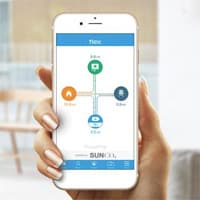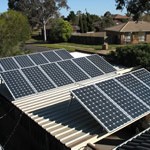If you own a solar panel and battery storage system, solar power monitoring questions like the following have probably crossed your mind:
‘Are the panels generating power right now? Is the battery charging? Did the home use mostly grid power or solar power last week? How would I know if it all stopped working?’
In this article we show rooftop solar system owners how they can monitor the amount of electricity they’re generating, how much they are storing in their battery, and how much they are drawing from panels, the grid and their battery — all without having to leave the lounge room.
Rooftop solar – the quiet energy revolution
Your rooftop solar system operates silently. If it stops generating power, your house will start to draw energy from the main electricity grid. If the battery is full and your solar system has excess power, it will automatically feed this into the grid
All this activity is done silently, without your knowledge. You could be earning money from your feed in tariff or paying your retailer for using power from the grid, and you would never know.
But thanks to the ‘Internet of Things’ any electrical device can, with a bit of added tech, be connected to the internet so you can monitor it.
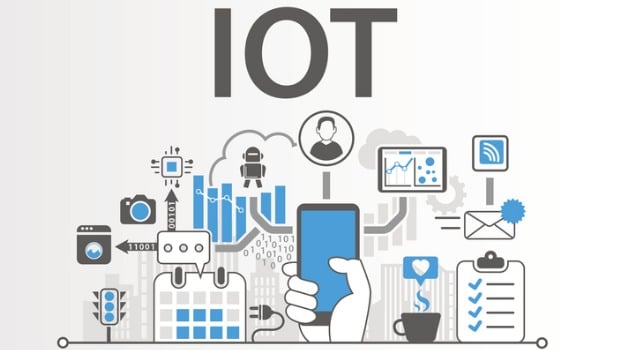
‘Internet of Things’ simply means “things that are connected to the internet”. It’s a relatively recent development, because in the past the internet could only connect computers to other computers.
Today, it can connect computers, phones, lights, air-conditioners, fridges, TVs and security alarms. These can all be connected to the internet and monitored/controlled by apps on your smartphone, laptop, PC or tablet.
Wi-Fi – the great connector
Most of us have Wi-Fi in the home, which is the most common way to connect home electrical devices to the internet. And since your solar panel and battery system is probably the biggest electrical device in the home. It makes sense that, just like other electrical items, it can be connected to the internet through Wi-Fi and then monitored.
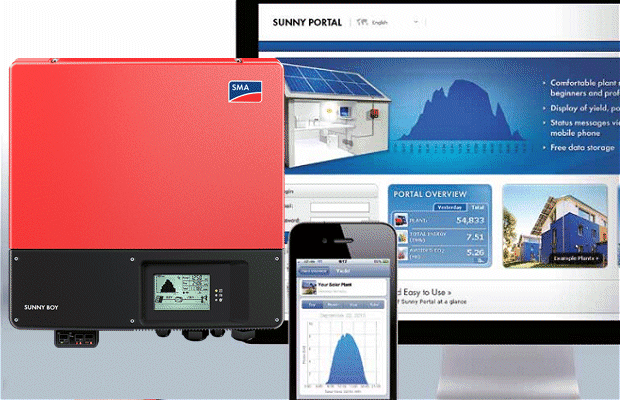
What are the advantages of this? Well, all the information about electrical currents flowing from your solar panels to your inverter, like the SMA inverter pictured above, can be sent to your phone, laptop or tablet. Your inverter is like the traffic warden, directing flow from your panels to your battery or back to the grid.
By monitoring the inverter you can see how much power you are using at any time, and whether that power is coming from your solar panels, your battery or the main grid. You can see whether your battery is being charged, or whether your are using battery power. It shows when you are feeding power into the grid and when you are drawing grid power.
You can also see if the system has gone down, and even receive emails to warn you of problems within the system.
Wash your clothes with sunlight, not grid power
Imagine the advantages of monitoring your energy use. You’ve just put a load of clothes in the dryer and are about to put a new load of washing on. But when you check your solar power monitoring app, you notice that the power for the dryer is coming from your battery and battery use is high. That’s because it’s already dark and your solar panels are not generating power.
To avoid using too much battery power, you decide to leave the washing until tomorrow. You could put it on now, but then you would have to pay for grid power to dry it since you are already drawing a lot of energy from the battery.
This is one example of how knowing how much power you are using and where that power is coming from can help you cut your energy bills and make the most of your solar panels and battery.
Solar power monitoring from Flex Energy Monitor
The Flex Energy Monitor sends information from your solar system to your monitoring device via Wi-Fi or 3G. It tells you how much you are using in real time, and where that power is coming from: panels, battery or grid. It also tells you how much power your solar panels are generating, and whether you used it, stored it or sent it to the grid.
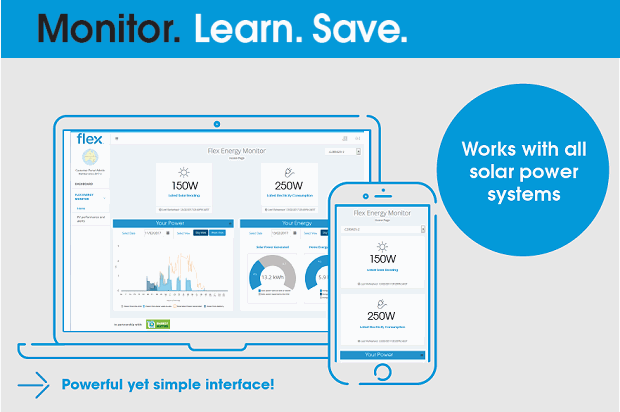
You can go back and compare different days to see how your use is changing. You may notice that Wednesday a fortnight ago you used twice as much energy from the grid as you did last Wednesday.
Over time you can use this historical data to make predictions about how much solar, battery or grid energy your home uses at different times of the year. This can help you make decisions about power use and budgeting for power bills.
Flex PowerPlay builds monitoring into your system
If you want to make sure you have online solar power monitoring built in to your system, PowerPlay is the solution. PowerPlay comes from Energy Matters’ parent company Flex and has three parts:
- Solar panels
- Home battery
- Monitoring system
What makes PowerPlay unique is the power monitoring and controlling system. You can monitor your power generation and energy use in real time on a smartphone, laptop or tablet. There is no lag as there is in some monitoring systems. When the microwave turns on you see the energy used straight away on the monitoring app.
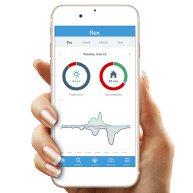
Once connected to the internet, PowerPlay also controls smart technology enabled appliances. You can program it to turn your lights on when it gets dark and off when it’s light. You can remotely control your air-conditioner and automatically turn lights and TV off. As long as the appliance has Wi-Fi connectivity, you can monitor or control it with PowerPlay.
PowerPlay’s three areas of energy
The PowerPlay package combines the three areas of energy independence, because it can:
- Generate energy – with an efficient solar panel system
- Store energy – in your home battery for when you need it (e.g. at night)
- Optimise energy use – by monitoring your power generation and usage. PowerPlay then diverts solar energy to your smart appliances.
Of course, you don’t have to use the PowerPlay or Flex Energy Monitor systems. Your solar power system should have monitoring of some sort built in, to allow you to connect to the internet. Sonnen batteries, for example, have a smartphone app that allows you to monitor battery charge and control connected appliances.
Whatever solar power monitoring system you use, you will soon become reliant on the important information it supplies about your electricity use. By getting the most out of your solar panels and battery, you will not only save money. You will also contribute to a reduction in carbon emissions. Solar power monitoring is the way to a cleaner, cheaper energy future.
Get a quick solar quote, or contact us today toll free on 1800 EMATTERS or email our friendly team for expert, obligation-free advice!









